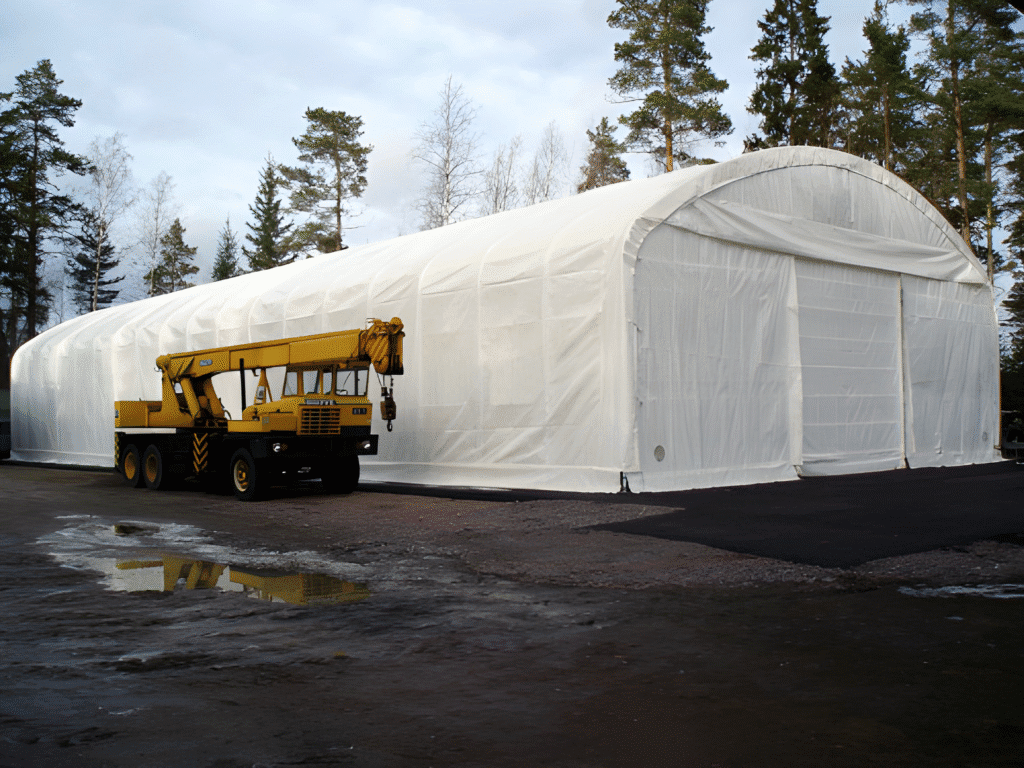By Terry Yang, Marketing Manager, ToughCover Tent&Shelter
Introduction
In today’s fast-paced supply chain, logistics teams face constant pressure to maximize storage efficiency, protect inventory, and control costs—especially in outdoor or semi-open environments. Heavy-duty storage tents (often called warehouse tents or container shelters) are emerging as versatile, cost-effective solutions for these challenges, bridging the gap between temporary coverage and permanent structures.
1. Fast and Flexible Storage Expansion
Traditional warehouses take months to build and millions to fund. In contrast, a heavy-duty storage tent can be operational within one week, offering an immediate 500–2,000 m² space. For logistics operators exploring scalable options, storage tents offer a practical balance of durability and deployment speed—especially for semi-permanent needs or leased facilities. This flexibility allows logistics managers to:
● Respond quickly during peak seasons
● Set up staging areas during international shipments
● Avoid long-term capital investments until demand stabilizes
Case in point: A European farming co-op deployed a 1,200 m² tent in 10 days, avoiding a multi-month construction delay—while increasing storage utilization by 35% in the first harvest season.
2. Enhanced Inventory Protection & Quality Assurance
Unpredictable weather—ranging from heavy rain to intense sunlight—can damage stock or spikes humidity inside open-air storage. Heavy-duty tents, constructed from rip-resistant, UV-blocking PVC and featuring reinforced steel frames, offer:
● Protection comparable to permanent buildings
● Improved pest and dust control
● 30–40% reduction in product spoilage over 12 months
Example: A Southeast Asian agro-packaging center shifted grains to sealed tents and reduced spoilage by 25%, compared to open-air storage.
3. Operational Cost Efficiency
Compared to rental warehouse spaces, tents deliver significant cost savings. According to a recent comparative study on modular logistics structures, temporary structures can reduce setup time by up to 80% while maintaining similar protection standards.
Based on a 1,000 m² unit:
| Cost Factor | Warehouse Rental | Tents |
| Annual Cost (USD/m²) | $100–150 | $25–40 (amortized) |
| Maintenance | High | Low (PVC cleaning) |
| Setup Time | 3–6 months | 1 week |
Over a 3 years lifespan, tents can cut operational storage costs by up to 60%—helping allocate capital to core logistics infrastructure. For a detailed breakdown of installation steps, refer to how to assemble a storage tent guide.

4. Optimized Workflow Design & Scalability
Modern storage tents can be tailored with roll-up doors, office annexes, mezzanine decks, and industrial lighting—supporting both stacking and staging activities. A modular system allows logistics teams to:
● Reconfigure layout for changing SKUs
● Add or remove storage bays based on demand
● Integrate forklifts/pallet jacks easily thanks to flat ground surfaces
At ToughCoverTent, we helped an Australian 3PL company reconfigure a 1,500 m² tent 4 times during peak season, increasing pick-line efficiency by 20%.
5. Sustainability & Environmental Benefits
Eco-conscious supply chains increasingly prioritize sustainable solutions. Heavy-duty tents:
● Require fewer concrete or steel foundations
● Can be relocated or recycled as demand shifts
● Reduce construction waste and embodied carbon
Partnering with clients, we’ve documented up to 18% lower carbon footprint in storage deployment compared to new mini-warehouses.
Best Practices for Implementation
✅ Site Preparation: Ensure firm, leveled base and drainage
✅ Climate Consideration: Select insulating liners or ventilation for hot/humid environments
✅ Regulatory Compliance: Know local zoning and fire safety codes
✅ Maintenance Plan: Schedule regular inspections (every 6 months) and deploy draft-proof seals
✅ Modular Investment: Begin with a core unit—expand in 500 m² increments
Conclusion
Heavy-duty storage tents are no longer just temporary shelters—they are strategic logistics assets enabling rapid expansion, product protection, operational flexibility, and sustainability. A recent DHL: Improve Logistics Operations emphasized the importance of rapid infrastructure deployment in uncertain supply chains.
By adopting high-quality tents, logistics managers gain a competitive edge—balancing speed, cost, and control. If you are exploring ways to optimize storage infrastructure, consider the role of flexible, heavy-duty tent solutions. They provide speed, cost-efficiency, and adaptability—key factors in today’s volatile logistics environment.
Bio:
Terry Yang is Marketing Manager at ToughCover Tent&Shelter, specializing in storage solutions for logistics and agricultural sectors. With over 15 years in industrial warehousing and supply chain optimization, we’ve helped businesses scale flexibly while cutting costs.








